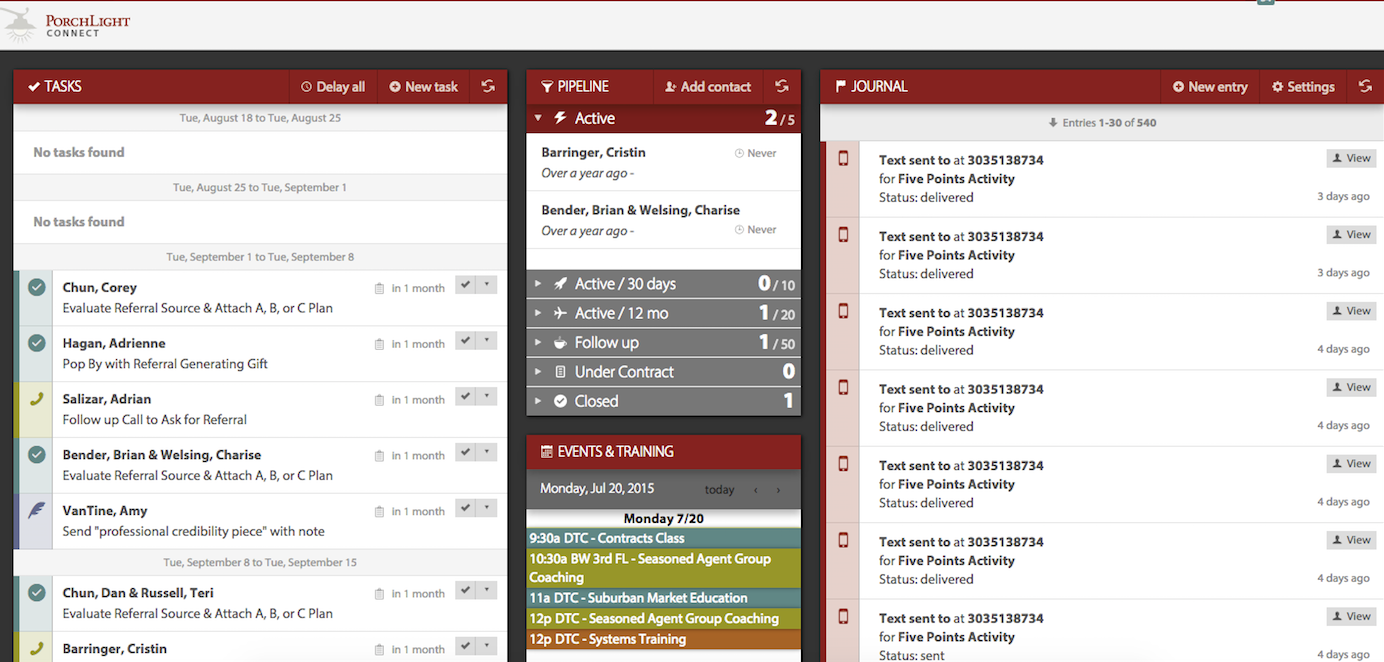Are you set up for success in 2016? Join 2,500 real estate industry leaders Aug. 4-7, 2015, at Inman Connect in San Francisco. Get Connected with the people and ideas that will inspire you and take your business to new heights. Register today and save $100 with code Readers.
Takeaways:
- Broker’s in-house tech platform helps agents generate more referrals.
- Broker handles marketing and tech for agents.
- Agents work less and are more productive.
Denver real estate agent Joy Castillo was exhausted, her life frayed by the heavy demands of running her business.
As a top producer in 2009, she worked 60 to 70 hours per week just to keep her head above water. “I couldn’t sustain working that much and being happy,” she said.
This all changed when she joined PorchLight Real Estate Group in 2010.
Castillo, a mother of three young children, now works an average of 35 hours per week, takes over a month off each year, and has steadily grown her production from an annual sales volume of $4 million in 2010 to $12 million in 2014.
That storyline is the 10-year-old firm’s design.
Business and life partners Carol and Amy Bayer built PorchLight to be the brokerage they wanted as agents: a full-service outfit that provided agents all the training, coaching, technology and marketing they need.
A decade in and the 140-agent firm is thriving. With $517 million in sales in 2014 on 1,388 transaction sides, it’s grown into one of Denver’s largest brokerages.
The firm has tweaked the traditional brokerage model with a design and in-house technology that increases referrals, improves agents’ productivity and quality of life, increases efficiency and spurs impressive growth.
By centralizing parts of the real estate process, PorchLight helps agents focus on what they do best. This gives PorchLight happier, more productive agents, plus satisfied clients, a more efficient workflow, potentially higher margins and impressive growth.
| With PorchLight longer than: | Average production in last 12 months | Estimated agent income |
| 1 year | $6.0 million | $104,400 |
| 2 years | $7.1 million | $133,110 |
| 3 years | $7.7 million | $148,770 |
| 4 years | $8.3 million | $164,430 |
| 5 years | $9.1 million | $185,310 |
| 6 years | $13.2 million | $292,320 |
| 7 years | $14.8 million | $334,080 |
Source: PorchLight Real Estate Group
“I don’t have to do anything that isn’t my job: buying and selling and customer care,” Castillo said.
The PorchLight way
Castillo does no lead generation. All of her business comes from referrals.
This fits PorchLight’s model. Ninety-five percent of PorchLight’s deals come from referrals, according to Bayer.
To help its agents stay in touch with their past clients and contacts, PorchLight built its own software platform, “Connect.”
Connect grades contacts on their readiness to transact or refer, gives agents suggested daily follow-up tasks, provides clients a window into their transaction and a way to communicate with their agent.
The software also provides agents market statistics, MLS search and all the real estate forms they need to complete a deal. And automated searches alert agents’ clients when a house sells in a neighborhood they’re interested in.

Screenshot of the agent dashboard in PorchLight’s Connect software.
Castillo puts all of her past buyer and seller clients on a plan. The platform ranks her contacts in different tiers, allowing her to efficiently follow up with those most likely to refer her business.
Seven grade A contacts currently refer her approximately 30 clients each year; they get a quarterly face-to-face meeting. Grade B contacts have sent her referrals in the past; they get less frequent contact. Grade C are those who she’d like to work with again; they get a monthly touch through the automated system.
PorchLight has a robust training and coaching system.
The firm brings on only agents who work full-time and are committed to providing a high level of service, Bayer said.
The onboarding process includes in-depth training and lots of accountability.
“We teach how to give, provide great service and then ask for referrals,” Bayer said. The firm also checks in to see how many connections new agents make each week.
Along with superior service, culture is important to PorchLight.
Its open layout of its four offices reflect this value. The firm wanted to promote camaraderie and guard against the cutthroat feeling that can emerge when agents feel they are competing with one another, Bayer said.

Conference room at one of PorchLight’s four offices.
Full service’s costs & benefits
The firm has 40 staff members, giving it a ratio of nearly one staffperson for every three agents. This helps it offer top-notch training, marketing and tech support to agents.
PorchLight’s full-service approach is not cheap; agents pay for it.
All agents start the calendar year at a split of 60/40 with the firm. But after their gross commission passes $72,500, they move to a 90/10 split for the rest of the year.
That initial split may sound high, Castillo said, but she used to spend $38,000 each year on marketing. With PorchLight, she spends none.
Castillo said she usually hits the 90/10 threshold by Aug. 1 each year.
An agent’s PorchLight
Castillo participated in PorchLight’s coaching program for a full year when she first joined. She has the systems firmly in place now, but she still takes part in the in-depth neighborhood classes the firm holds.
Those classes showcase everything about a neighborhood agents need to know: where the pools are, market trends, the makeup of its commercial center.
Since she has a full tech and marketing team behind her, Castillo said servicing clients is a breeze.
When she gets a listing, she emails the office. PorchLight staffers handle photography, putting in yard signs, cleaning and staging the home, creating and designing a marketing plan, and coordinating an open house.
They also send clients a timeline of events, which highlights when and how they should be involved.
What does all this mean to Castillo?
Less work, more confidence and a growing business.
“I’ll never join another company,” she said.









